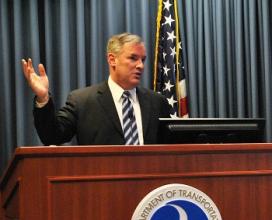Resilient Infrastructure Can Take a Licking and Keep On Ticking
"Overcoming adversity used to be part of the American DNA. Can we build that back into our national character?"
It's more than a philosophical question for Stephen Flynn, co-founder of the George J. Kostas Research Institute for Homeland Security and professor of political science at Northeastern University. Flynn is passionate about preparing transportation and other infrastructure to withstand attacks from nature, time, and malicious actors. "It's not enough to 'protect' a specific asset, such as a bridge," he said. "You want to design the whole local or regional system to recover quickly from whatever is thrown at it."
Flynn presented his views at a recent Straight from the Source event at Volpe, The National Transportation Systems Center. "The old approach is to identify threats and protect against them," said Flynn, but this doesn't work well for infrastructure, which takes years to build and is supposed to last for decades. "We need to shift from protecting individual assets to assuring continuous function of the infrastructure," whether it's a transport system or an electrical grid, said Flynn.
Flynn likes a systems operations model, which asks, "What are our critical needs? What are the systems that fill those needs? What could disrupt the systems?" The biggest current threat to our transportation system is neglect, said Flynn. "A previous generation buckled down and paid for all this infrastructure. We're like kids who inherit their grandparents' mansion and don't bother to keep it up."
Flynn said a resilient system is characterized by robustness, resourcefulness, rapid recovery, and adaptability. For example, more extreme weather is certain in the future, so it's key to set up systems that can recover relatively quickly from hurricanes, fires, floods, and drought. The Sacramento River Valley is a case in point. The valley lies below sea level, protected from saltwater inflow by a network of aging levees. The levees are built of sand—ideal material for animal burrows and trees—and were not designed to withstand earthquakes greater than 6.8 on the Richter Scale. "The next earthquake will liquefy the sand, and saltwater will rush in, ruining the water supply for all of central California," said Flynn. "It's a matter of 'when,' not 'if.' The question is: do we have the ability and will to design and implement a solution?"
See video highlights of Flynn's talk on Volpe's website.
For more on Flynn's thinking, see his recent book The Edge of Disaster: Rebuilding a Resilient Nation (Random House, 2007) and his CNN opinion piece "America isn't ready for superstorms."

Stephen Flynn, co-founder of the George J. Kostas Research Institute for Homeland Security and professor of political science at Northeastern University, spoke about infrastructure resilience during a recent Straight from the Source event at Volpe. (Volpe photo)
